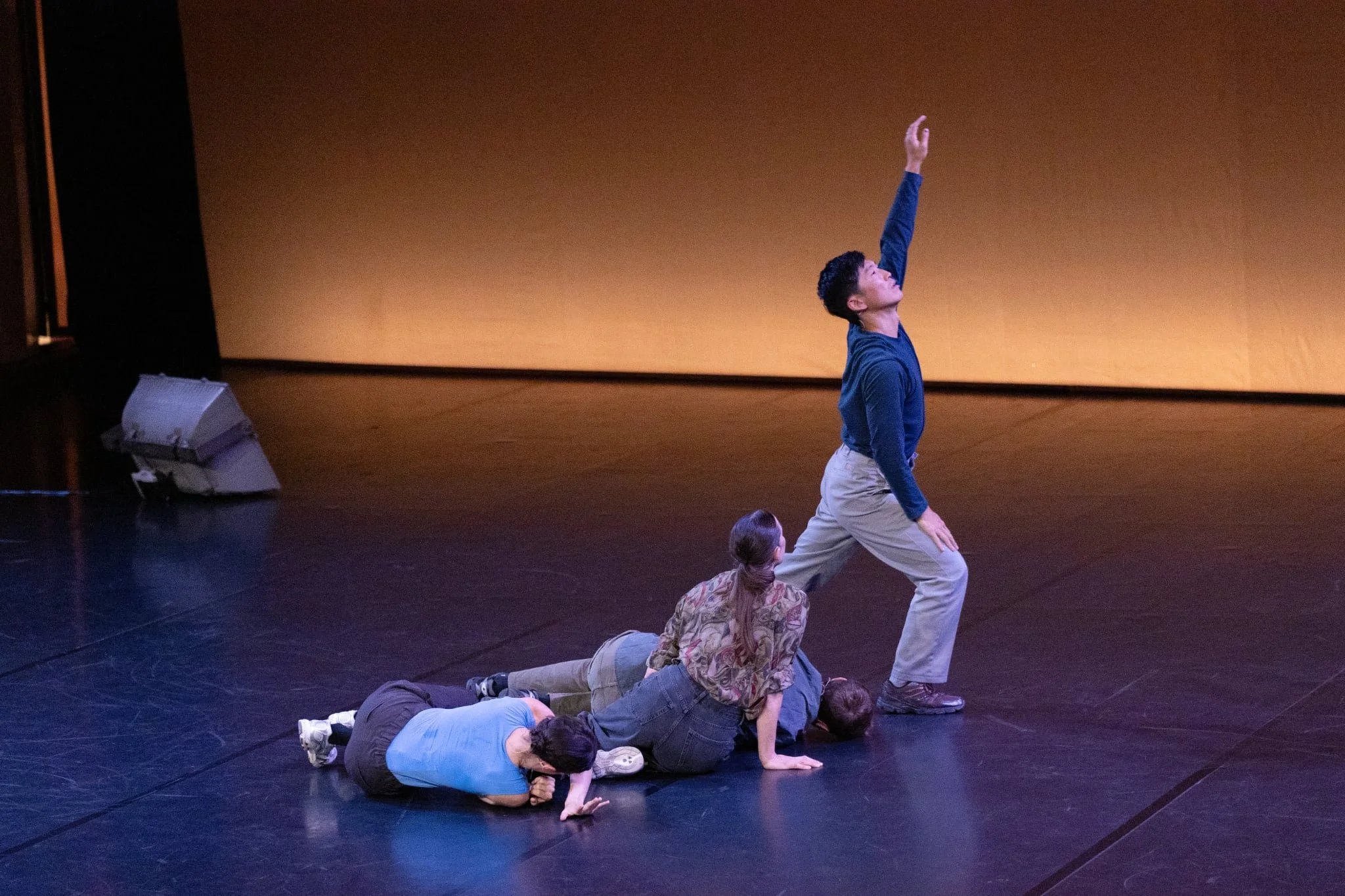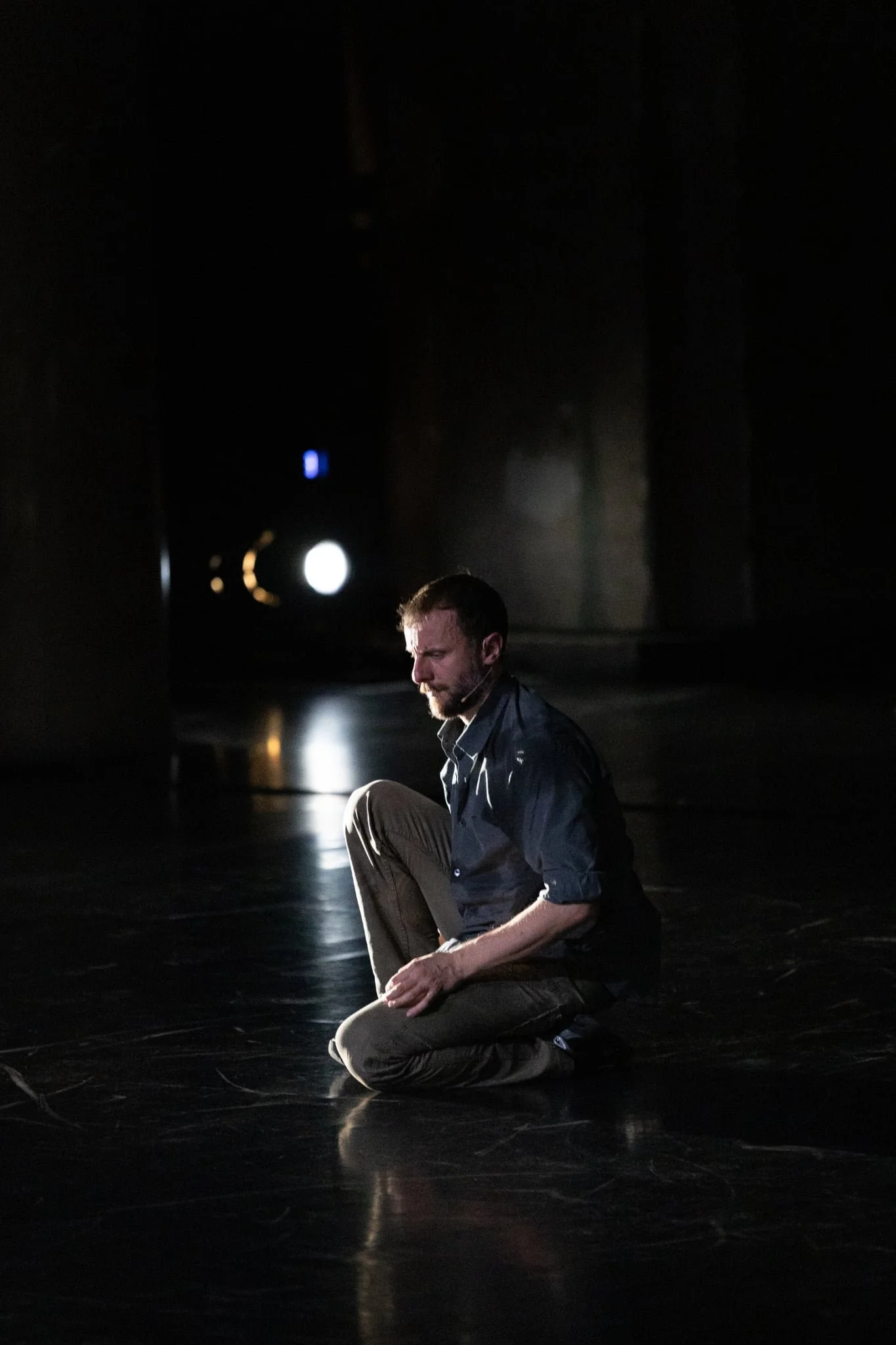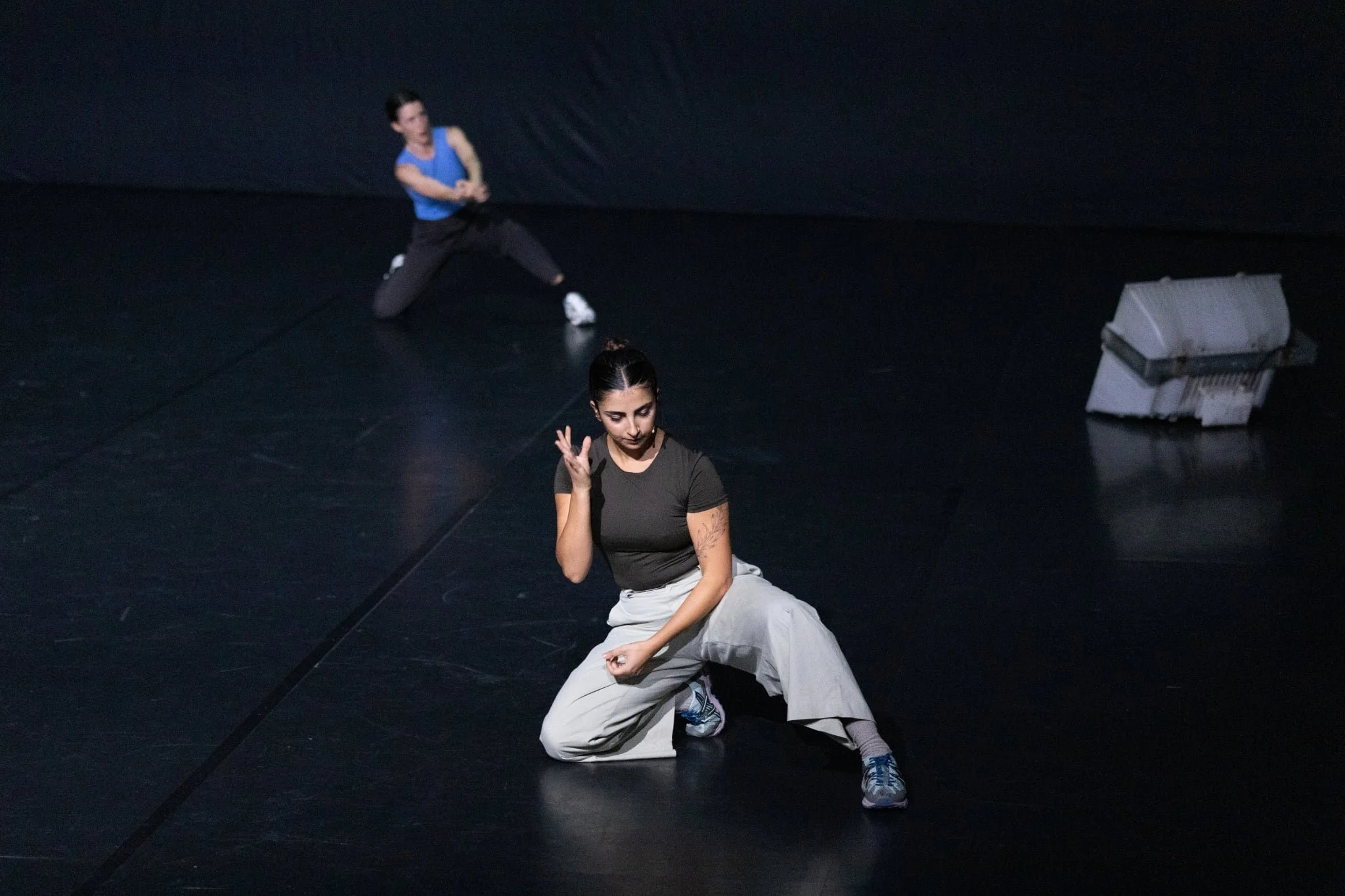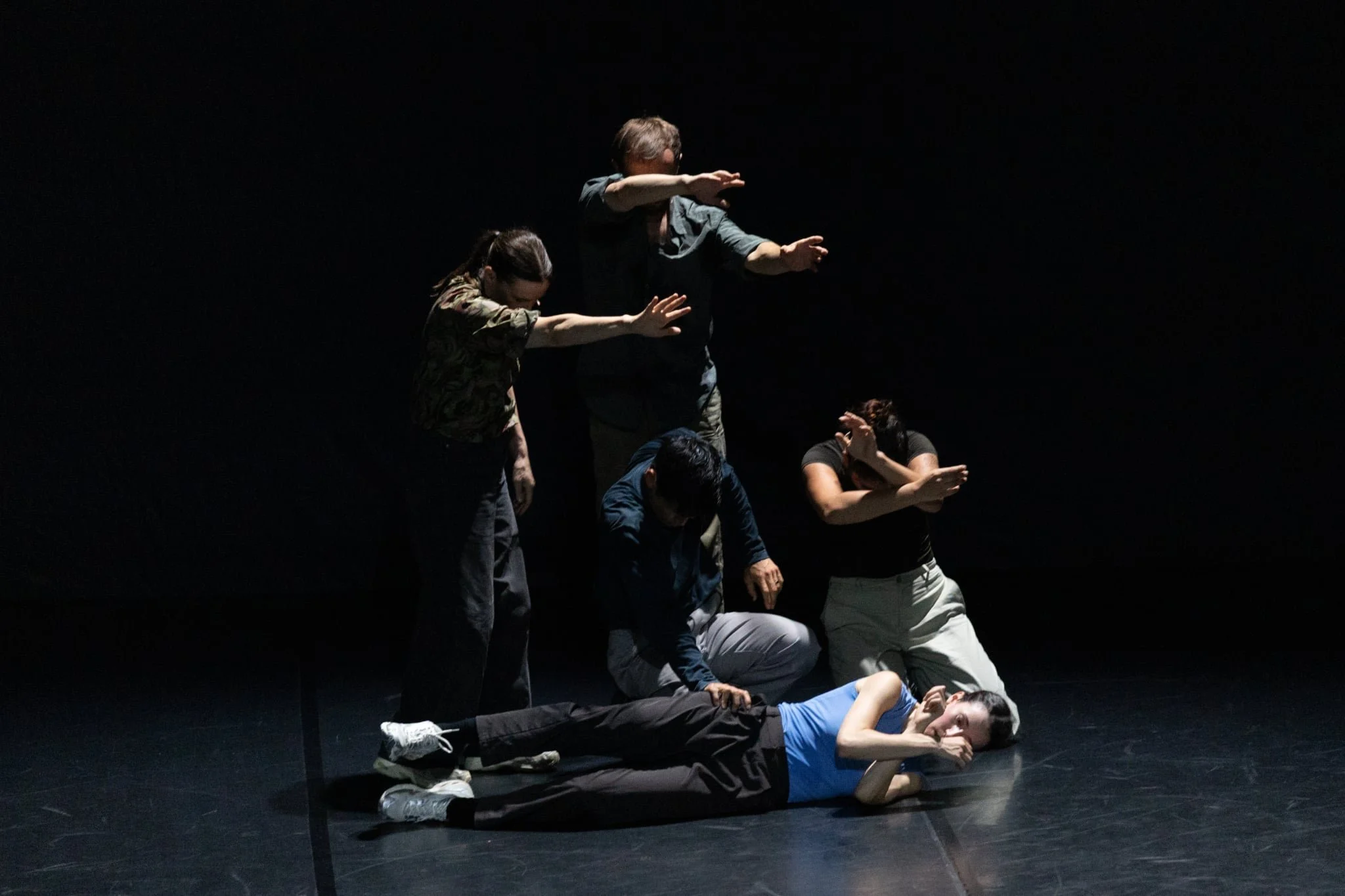Earth Works by Sergiu Matis, at the Vienna Odeon Theater, on July 11, 2025, as part of ImPulsTanz Festival 2025
by Simona Noja-Nebyla
Earth Works is a dance piece by Sergiu Matis, a Romanian choreographer born in Cluj-Napoca and educated in Romania and Germany. Premiered in December 2024 in Berlin, it draws on reflections by authors from different parts of the world, recounting their personal experiences with the threatened environment.
Through words, sentences, and images, the text carries the five performers: Lisa Densem, Moo Kim, Sergiu Matis, Nicola Micallef, and Manon Parent, who, in turn, embody the movements generated by the written and spoken word in space. In this live exchange of knowledge, we, the audience, encounter ancestral essences of cultures (often unfamiliar to most Europeans) and their messages.
Metaphors like “Water is the first story of place” or “A river is the song of running water” echo within us the ancient Greek memory of Thales of Miletus, who believed that everything began with water. There is an immediate connection between us and the Wiradjuri belief (Australia) as “people of the rivers.” We recognize that rivers belong to all of us, that they, like us, want to keep flowing, evolving. Jeanine Leane goes even further: “Rivers are us.” As long as water can flow, there is life—something that should never be stopped or broken. “If a deity is a force that can either create or destroy all life, then water is our highest power. What retribution will the future bring if we fail in our reverence for rivers?” [Leane, J. (2025). Galing-gu giiland. In Earth Works (Performance program, pp. 6–8). Vienna.]
Translated into movement, the dancers know no boundaries of embodiment; they are alive as long as they can move and bring ideas into manifestation. Through their bodies, the dancers let truth flow. If words may abstract meaning, the dancers carry the detailed significance of each thought, delivering it into virgin territories of sense—making it visible, perhaps newly understood, and why not, loved for the first time.
Photo@Boris Nebyla
Wiradjuri poetry is polyphonic; it holds ancestral voices, personal memory, communal trauma, language, resistance—all together, in a layered and powerful way. In a Western literary context, this idea is famously explored by Russian thinker Mikhail Bakhtin, who described the novels of Dostoevsky as “polyphonic”, allowing multiple moral, social, and philosophical voices to speak without the author imposing one “final truth.”
Is polyphony a renewal of the syncretic primordial arts?
Does bringing many voices together in poetry or art revive an older, foundational way of making art—one inherently blended, ritualistic, communal, before divisions like “high” and “low” art or “Western” and “Indigenous” systems?
In the context of Wiradjuri poetry (and many Indigenous poetics), polyphony is not a postmodern innovation; it’s a continuation of ancient practices. Oral traditions have always been multi-voiced: ancestor stories, songlines, past and present intertwined. Colonialism tried to flatten or silence this multiplicity, though poets like Jeanine Leane reclaim and re-weave those many voices—it’s both renewal and resistance.
But polyphony isn’t always syncretic in the sense of blending traditions into one. Sometimes, it’s about holding differences without erasure. For example, English and Wiradjuri languages can sit together in a poem without merging — they rub, resist, echo, but don’t collapse into a single hybrid.
The five dancers do something similar. Their polyphony of movement, shaped by different backgrounds, acts as a renewal of long-forgotten, deeply anchored emotions — vivid now as they were back in time. Modern systems may have suppressed this, but movement often goes beyond words, carrying secrets that only human bodies can hold.
More than that, in Earth Works, the return to origins carries less the weight of nostalgia and more the hidden, mysterious, transformative power of revealing the truth.
“In order to understand, sometimes we have to go back to the beginning. [...] Our ancestors measured distances through an understanding of currents [the Pacific Ocean] by feeling the breeze and following a map of the stars with a map that existed in the mind, and was transmitted down through generations via storytelling and connection to the environment.” [Aoake, H. P. (2025). Whatungarongaro te tangata, toitu te whenua — people fade away, but the land remains. In Earth Works (Performance program, pp. 10–21). Vienna.]
The “huge body of water with dotted islands in between big continents” can be seen as a giant wheke (octopus) that interconnects pieces of land across the ocean, suggests Hana Pera Aoake, a New Zealand author and researcher. She suggests that if we understand our whakapapa (foundational explanation not only for why life came to be, but also how it should be lived), we are grounded to the earth and know where we belong.
An explanation might be needed here: the Australian Wiradjuri are distinct from the Māori.
Both Māori (Aotearoa/New Zealand) and Wiradjuri (Australia) are Indigenous peoples with deep ancestral ties to their lands, not just as territory, but as living kin (whenua in Māori, Ngurambang in Wiradjuri). Both hold worldviews where human, non-human, spiritual, and natural worlds are interconnected. Ancestors, animals, rivers, mountains, and plants are seen as living beings or relatives. While Māori are Polynesian (part of the larger Austronesian family), having sailed to Aotearoa around the 13th century from eastern Polynesia, the Wiradjuri are Aboriginal Australians, part of one of the oldest continuous cultures on Earth (60,000+ years), with completely different ancestral origins and migration history.
As Hana Pera Aoake suggests, the performers of Earth Works seem to know where they belong. Sergiu Matis lets his roots of Romanian culture — shaped by layered influences (Roman, Slavic, Balkan, and more) — braided over time into a singular, living tradition — meet other cultures with ease, respect, and curiosity. The Māori worldview becomes close and familiar, because “we don’t own land, we belong to it” (Hana Pera Aoake). It looks like a fairy tale. Sometimes, it can become a horror. But dancers give us hope. They remind us how we can rewrite stories about places that are sacred, as in Māori belief, “of the beauty of Te Wai u o Tūwharetoa that has not yet been destroyed.” (Hana Pera Aoake).
This might not be easy. As the Nigerian Rahima Gambo asks herself:
“Is natural catastrophe an exercise in abstract expressionism, a Pollock canvas waiting to happen? In natural catastrophe, there may be no answers, but there is music, improvised and lilting, moving from note to note, until it reaches a chaotic frenzy.” [Gambo, R., with Tatsuniya Artist Collective. (2025). Termite splatter. In Earth Works (Performance program, pp. 24–25). Vienna.]
Yes, there might be hope where we can see music and hear dance. Yet, we must pay attention to “a special rock somewhere”—because if mined, “Jamaica will sink”. “A sinking island within this mytho-poetic landscape is not only water rising but the land itself folding in on itself.” [Morrison, H. (2025). “A special rock somewhere”. In Earth Works (Performance program, pp. 28–29). Vienna.]
There is danger everywhere, and “the blood wants to fly.” We are “alone but not really.” The fire hidden by the mangroves reminds us, in a Heraclitean way, that all things transform constantly. It suggests that the spirit, memory, or cultural presence of the Javan tiger continues, even if the animal no longer exists physically. It evokes resilience, survival, or wildness that persists against all odds. “Lineage is not a downward line.” Even colonialism could not destroy it. Because lineage is not just ancestry flowing from past to present in a straight, vertical line—parent → child → grandchild. Lineage is relational, circular, and web-like. In many Indigenous and relational worldviews (including Wiradjuri and Māori), lineage is not linear but networked—it includes relationships across generations, non-human kin (animals, plants, rivers), ancestors and future descendants, land, memory, and spirit. Lineage is responsibility, not just inheritance. It’s not only what you get from those before you, but what you carry, care for, and pass in multiple directions. It radiates in many directions: backward to ancestors, sideways across the community, forward to those yet to come, and outward to land and more-than-human relations. [Jay, P. (2025). My blood wants to fly. In Earth Works (Performance program, pp. 32–34). Vienna.]
In this sense, the destinies of human beings are deeply entangled with the elements of nature and plants. “Suddenly life is a flower, a small flower by a lakeshore” [Valkeapää, L., & Valkeapää, O. A. (2025). Life is... In Earth Works (Performance program, pp. 36–37 Vienna.)] As Leena and Oula A. Valkeapää, following the Sámi tradition of the people of Lapland (Finland), live with reindeer and believe, these animals are ancestral beings, part of our cosmic and shamanic journeys. They are central life-givers—providing food, clothing, tools, mobility, and spiritual connection. Beyond that, the reindeer embodies cycles of life, migration, survival, and reciprocity with nature. Across cultures, mythological readings often see reindeer as mediators between worlds (earth-sky, human-spirit, living-dead), carriers of light and movement through darkness (especially in the polar night).
Is the reindeer not similar to a dancer—a cosmic traveler bringing a lifeline across space and time, performing a movement that occurs here and now, between river and ocean?
Photo@Boris Nebyla
Even if Sergiu Matis tends to believe that “Nothing remains” (2024), his unpublished poem, Earth Works is a poetic dance plea about ephemerality and disappearance, environmental grief and embodied memory. And even if it echoes a meditation on endings, one feels it deeply also as a provocation: what might endure beyond ruin?
Photo@Boris Nebyla
A river as the song of running water?
A special rock somewhere?
A small flower by a lakeshore near reindeer?
Or maybe it is only our meaningful, daring effort to understand the whakapapa through dance?
Photo@Boris Nebyla
Credits
Concept & Choreography
Sergiu Matis
Performance
Lisa Densem, Moo Kim, Sergiu Matis, Nicola Micallef, Manon Parent
Text Contributors
Hana Pera Aoake, Rahima Gambo, Priya Jay, Jeanine Leane, Harun Morrison, Leena Valkeapää, Oula A. Valkeapää
Dramaturgy
Mila Pavićević
Music
Antye Greie-Ripatti (AGF)
Set & Lighting Design
Ladislav Zajac
Costume Design
Lisa Densem, Philip Ingman, Moo Kim, Sergiu Matis, Nicola Micallef, Manon Parent
Choreographic Assistance
Laurie Young
Technical Direction & Sound
Andrea Parolin, Ivan Bartsch
Voice Coaching
Jule Flierl
Editorial Direction
Harun Morrison
German Translation
Calvin Lanz
Production
Anna Chwialkowska, Philip Ingman
Distribution & Touring
Philip Ingman
Production Information
A production by Sergiu Matis
Funded by Hauptstadtkulturfonds, Berlin (DE)
Co-produced by Teatro Nacional Dona Maria II Lisbon (PT) as part of apap – FEMINIST FUTURES (funded by the Creative Europe Programme of the European Union), PACT Zollverein Essen (DE), Radialsystem Berlin (DE), Tanzfabrik Berlin (DE)
Supported by Kunstencentrum BUDA Kortrijk (BE) as part of apap




